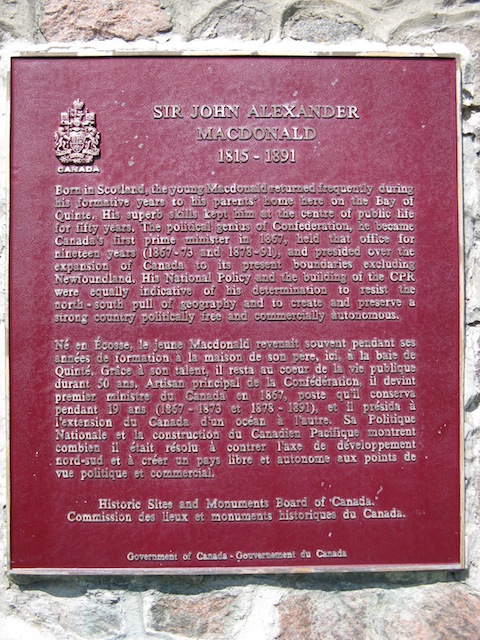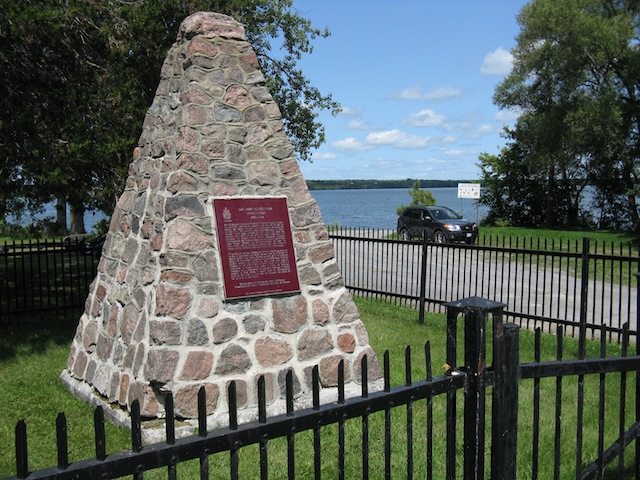Ontario's Historical Plaques
at ontarioplaques.com
Learn a little Ontario history as told through its plaques
Sir John Alexander Macdonald 1815-1891

Photos by contributor Wayne Adam - Posted December, 2009

Plaque Location
The County of Lennox and Addington
The Town of Greater Napanee
At the Hay Bay Boat Ramp, north side of Shore Road
.2 km west of Hay Bay Church
Coordinates: N 44 06.072 W 77 01.324 |
Plaque Text
Born in Scotland, the young Macdonald returned frequently during his formative years to his parents' home here on the Bay of Quinte. His superb skills kept him at the centre of public life for fifty years. The political genius of Confederation, he became Canada's first prime minister in 1867, held that office for nineteen years (1867-73 and 1878-91), and presided over the expansion of Canada to its present boundaries excluding Newfoundland. His National Policy and the building of the CPR were equally indicative of his determination to resist the north-south pull of geography and to create and preserve a strong country politically free and commercially autonomous.
Related Ontario plaque pages
Sir John A. Macdonald 1815-1891
Sir John Alexander Macdonald 1815-1891
John A. Macdonald in Hallowell
Earnscliffe
Related Toronto plaque pages
Sir John A. Macdonald 1815-1891
The Macdonald-Mowat House
More
Information
More
Politicians
Here are the visitors' comments for this page.
Posted October 25, 2011
This plaque to Macdonald's boyhood home originated with local resident Arthur Ross Davis, who owned the land and had written to officials (including four Prime Ministers) over a period of two decades. In 1926, the national Historic Sites and Monuments Board (HSMB) rejected the idea. Davis responded by suggesting to Mackenzie King that both Macdonald and Laurier be honored at their boyhood homes. Within 10 days, another body, the National Committee for the Celebration of the Diamond Jubilee of Confederation, embraced the idea.
The committee won support of the HSMB to write the inscription for a plaque, even though the latter had rejected the idea of marking Macdonald's boyhood home only a year earlier. The original proposed text read:
"Sir John A. Macdonald, whose boyhood days, those critical years that
decide the character of the man, were spent here where loyalists had
carved new homes out of the wilderness. From this soil he drew the
inspiration to weld together the weak and scattered colonies of his day
into a strong and ambitious dominion, equal partner in the far-flung
British Commonwealth."
One researcher, Yves Pelletier, says the unknown author "highlights the continuing loyalist myth present in Ontario during the earlier decades of the twentieth century", and a "repetitive imperial commemoration of Canadian history which governed much of the HSMB activities between 1919 and 1950."
The text was shortened to: "Sir John Alexander Macdonald From this soil, home of the Loyalists, he drew inspiration to weld together the weak and scattered colonies of his day into a strong and ambitious Dominion, equal partner in the far-flung British Commonwealth".
The committee had allotted funds to pay for such plaques, and although its form followed traditional HSMB markers, with an elaborate illustrated frame containing the HSMB name, it identified the committee as being the body responsible for it. Despite the plaque, the site was not deemed a national historic site by the HSMB, an attempt to put further distance between the two bodies. (A rare example of such a marker in its original form can be seen in Kingston at 110 Rideau Street [see the third plaque on the page "Sir John Alexander Macdonald 1815-1891" on this website].)
This Adolphustown plaque was unveiled in 1927, but by 1980 was replaced with the current plaque for "reasons unknown". The current text redefines the public image of Macdonald yet again.
-Wayne
Reference: Yves Y. Pelletier, "The Old Chieftain‚s New Image: Shaping the Public Memory of Sir John A. Macdonald in Ontario and Quebec, 1891-1967", doctoral thesis, Queen's University, Kingston, 2010.
Here's where you can write a comment for this page.
Note: If you wish to ask me a question, please use the email link in the menu.
Note: Comments are moderated. Yours will appear on this page within 24 hours
(usually much sooner).